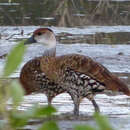Biology
provided by Arkive
The West Indian whistling-duck is considered a non-migratory bird and is active at night and at dusk and dawn. By day, single birds, pairs or flocks with up to 100 individuals come together to roost and occasionally feed in mangroves and swampy areas. At dusk they fly to other areas to feed in small flocks and return to their roost-sites just before dawn (2).
Nests are made between palm fronds, in clumps of bromeliads, on branches or in tree-cavities, though in Antigua they are built by scraping a shallow ditch in the ground and lining it with leaves (5). Pairs breed throughout the year, but there are peaks in the summer months (2).
Conservation
provided by Arkive
The listing of this species on Appendix II of the Convention on International Trade in Endangered Species (CITES) and the Convention on Migratory Species (CMS) legally protects it throughout much of its range (3)(4). However, law enforcement is inadequate. To improve conservation measures, in 1997 The West Indian Whistling-duck Working Group was set up. At present this vulnerable duck does exist in several protected areas, but it is thought that suitable habitat for it is insufficient (2). Conservation aims are now focussing on conducting extensive population and habitat surveys, monitoring current populations, enforcing better protection and increasing public awareness of this species' fragile status (5).
Description
provided by Arkive
The West Indian whistling-duck is a large, upright, long-necked duck. Adults are deep brown in colour, with black-and-white markings on the flanks, a whitish abdomen and black bill (2). This species can also be identified by its shrill'chiriria' whistle (5).
Habitat
provided by Arkive
Inhabits mangrove and swamp areas, brackish ponds, wetlands and tidal flats (5).
Range
provided by Arkive
As the name suggests this bird is found in the West Indies. Historically, this bird occurred throughout the Bahamas, Turks, Caicos Islands, Cuba, Cayman Islands, Jamaica, Haiti, Dominican Republic, Puerto Rico, Virgin Islands, St Kitts and Nevis, Antigua and Barbuda, and Guadeloupe. At present, breeding populations are known to exist in the Bahamas (at least 1,500 birds), Turks and Caicos, Cuba (possibly more than 10,000 with at least 6,000 in the east), Cayman (1,000 and increasing), Jamaica (500 and declining), Dominican Republic, Puerto Rico (100 and declining), Antigua (400) and Barbuda (possibly 2,000) (2).
Status
provided by Arkive
Classified as Vulnerable (VU B1+2abcde) on the IUCN Red List 2003 (1), listed on Appendix II of CITES (3), and on Appendix II of the Convention on Migratory Species (CMS) (4).
Threats
provided by Arkive
This large duck is threatened by poorly regulated and excessive hunting for food, eggs and sport (2). It depends on wetland habitats for food sources, protection and breeding, and so has suffered serious population losses following the rapid development of coastal areas in the Caribbean for development and agriculture (5). Of the remaining wetland habitats, 50% are severely degraded due the removal of mangroves and swamp-forest, pollution (especially over-use of pesticides) and natural catastrophes such as droughts and hurricanes (2). The populations of the West Indian whistling-duck are now small and fragmented (2).

